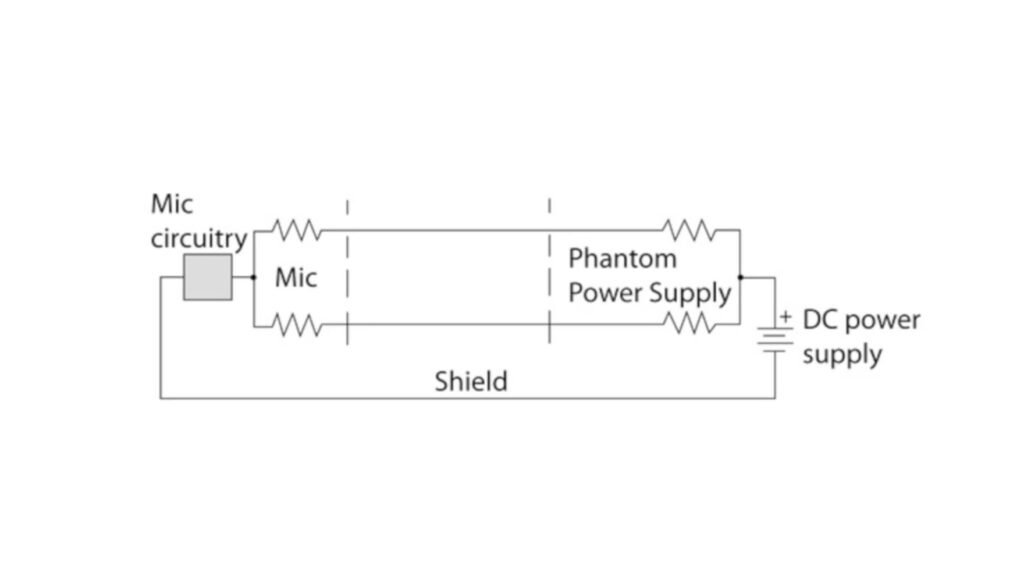The microphone is a great invitation for our digital world, of the huge popularity of microphones different kinds of microphones are available in the market.
One of the most popular microphones is the Condenser microphone microphone. Condenser microphones are best for recording and they are highly sensitive.
But some of these Condeser microphone need an additional power source which is known as Phantom Power.
Today we’ll talk about What is a Phantom Power Microphone, how it works, and why you should need a Phantom Power Microphone.
Quick Access
ToggleWhat is a Phantom Power Microphone
A condenser microphone is the most powerful microphone in today’s time, but some of the condenser microphones need an additional power source to turn on. Phantom power is a way of supplying a microphone with the necessary power to operate, typically 48 volts.
The purpose of phantom power is to energize the condenser element and internal microphone preamplifier. This results in a microphone with a high output level, excellent sensitivity, and low noise.
Phantom power is supplied to the microphone through balanced microphone cables, specifically the XLR type. It’s a “phantom” because the power is invisible, travelling over the same wires that carry the audio signal.
Therefore, a Phantom Power Microphone is an ideal choice for professional audio recording scenarios, delivering superior audio capture. It’s commonly used in studios, theatres, and broadcast applications.
How Phantom Power Microphone Works

Phantom power operates by sending a DC through the microphone cable, providing power to the condenser microphone. This current travels alongside the audio signal without interfering with it.
The power is supplied via the microphone cable’s balanced lines (pins 2 and 3) and returns through the ground (pin 1). This method allows for a clean and noise-free transfer of both power and audio.
Once the current reaches the microphone, the phantom power energizes the condenser element of the microphone. This action boosts the microphone’s sensitivity, ensuring an optimal audio capture.
The power also fuels the internal microphone pre-amplifier, boosting the microphone’s output level and enhancing its performance. The use of phantom power results in a high output level with low noise, making it perfect for professional recording.
Why You Should Need A Phantom Power
The phantom power supply is essential for some of those microphones, especially the phantom power supply is built for Condenser microphones. Here are a few reasons why you should need a phantom power supply:
- Enhanced Audio Quality: The use of phantom power ensures a clean and noise-free transfer of both power and audio signals, resulting in superior sound quality.
- Professional Recording: Phantom power microphones are commonly used in professional recording settings, such as studios, theatres, and broadcast applications. Using a phantom power microphone will result in high-quality recordings.
- Versatile Usage: Phantom power microphones are compatible with various devices, making them suitable for a wide range of recording scenarios. They can be used with audio interfaces, mixers, and other recording equipment.
- Cost-effective: While there are options for external phantom power supplies, many audio interfaces and mixers have built-in phantom power. This eliminates the need for an additional purchase, making it a cost-effective option for recording.
Phantom power microphones are an essential tool for recording professionals, offering superior audio quality and versatility in usage. With the right equipment and a proper understanding of how it works, a phantom power microphone can elevate your audio recordings to the next level.
Phantom power is an additional power source used to energize the condenser element and internal microphone preamplifier in some microphones, typically 48 volts.
No, only certain types of microphones, such as condenser microphones, require phantom power to operate. Other types, like dynamic microphones, do not need it.
Phantom power microphone used for professional audio recording scenarios, delivering superior audio capture. It’s commonly used in studios, theatres, and broadcast applications.
Condenser microphones need phantom power to operate, while dynamic mics do not. However, some ribbon microphones may also require it.
Phantom power is typically supplied at 48 volts, but some equipment may provide a slightly different voltage.
Not all of them, but some condenser microphones do require phantom power to function properly. It’s best to check the microphone’s specifications before use.
No, dynamic microphones do not require phantom power as they generate their electrical current through electromagnetic induction.



